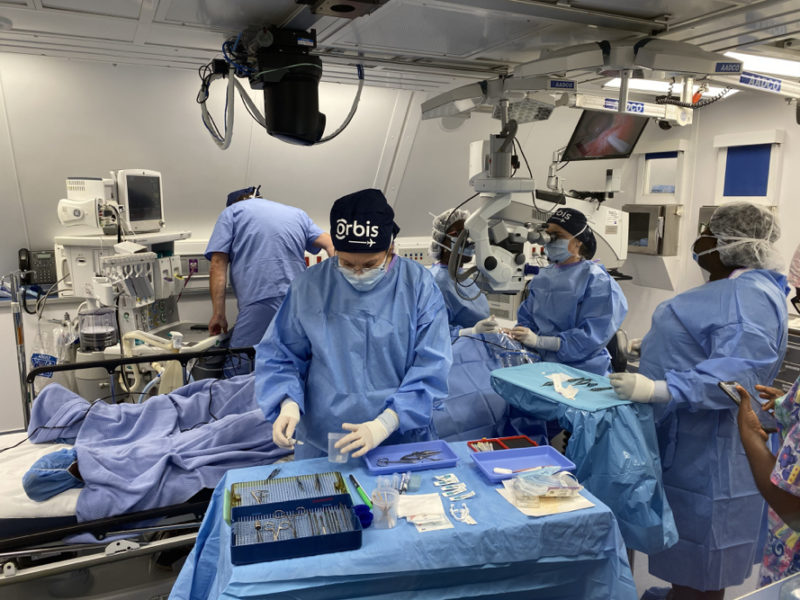

How a Flying Hospital is Changing the Way the World Sees What We Do 90 of Vision Loss Is Avoidable Our Vision & Mission We are an international non-profit that brings people together to fight avoidable blindness. Battsetseg to treat patients like Rose in their own communities. Tours will operate during Museum hours, 10:00 AM to 5:00 PM. For over four decades, Orbis has been fighting avoidable blindness by training eye care professionals like Dr. While much of that work gets done on its Flying Eye. The MD-10 aircraft was donated by FedEx, then custom redesigned and fitted to create the unique aircraft using modular technology. Orbis International has been a pioneer in preventing and treating avoidable blindness for 40 years. Orbis is headquartered in the USA with 15 international offices and has worked in over 90 countries. Orbis’s Flying Eye Hospital features 3D technology and live broadcast capabilities enabling Orbis, with their expert volunteer faculty, to train more doctors, nurses and healthcare professionals and ultimately treat more people and restore their sight. The Flying Eye Hospital is operated by Orbis, an international non-profit organization that flies the plane to low and middle-income countries to mentor, train and inspire local eye health teams so they can save sight in their communities. Thomas E.An MD-10 airliner converted into the world’s only flying eye care teaching hospital will make its first visit to Seattle and be stationed at the Museum for tours on July 28-29 and Aug. John Cavender – Mongolia, Vietnam, Cuba, Tanzania, Sri Lanka Mike Allen – Senegal, Trinidad, Jamaica, Singapore, India, China Many of these programs focus on the treatment and prevention of childhood blindness, cataract, trachoma and corneal disease.īelow is a list of Barkan members and the countries where they have served: Note that we would love to include all those who participated – please contact us with your details! They work particularly in rural areas and impoverished urban communities. Permanent offices in these countries are run by local staff who implement an array of multi-year projects to improve the quality and accessibility of eye care. In 1999, to build the capacity of local partners, long-term country programs in Bangladesh, China, Ethiopia, India and Vietnam were created and similar programs are also underway in parts of the Latin America and the Caribbean. The first flight took off from the Ellington Air Force Base in Houston on it first project to Panama in May 1982.Īs Orbis grew over the years, hospital-based training programs and fellowships were added to provide additional skills-building opportunities for eye care professionals. In Latin Orbis means “Of the Eye” and in Greek it means “around the world.”Ī grant from USAID helped to fund the project and United Airlines donated a DC-8 which was converted in into the world’s first fully functional teaching eye hospital. Paton persisted with the idea for a mobile teaching hospital and Project Orbis was officially launched in 1973, leading to a unique and lasting alliance between aviation and medicine. But the high costs of tuition, international travel and accommodations prevented most doctors and nurses in low-income countries from coming to the USA for training. It concerned him because 90% of the world’s avoidable blindness occurs in the developing world, so someone needed to try to close this gap. The idea of Orbis began when Paton, a faculty member of The Wilmer Eye Institute at John Hopkins and later President of the American Board of Ophthalmology, recognized the lack of eye care and ophthalmic teaching in developing nations where blindness was widespread.

However, our own Bruce Spivey, who was serving as CEO of the Academy, actively supported the idea, going on fundraising missions to raise awareness for the fledgling organization. Ed Maumanee, were very much against the concept. David Paton in the late 1960s many of those in the senior hierarchy in ophthalmology, including his mentor, Dr. It is also important to note that when was Orbis was first conceptualized by Dr. Rosalind Stevens in our Luminaries Section, who has devoted a significant amount of her career to Orbis efforts to fight ROP.) Link here. We are proud that many of our department members have participated in missions around the globe with Orbis International, known as the first Flying Eye Hospital.


 0 kommentar(er)
0 kommentar(er)
